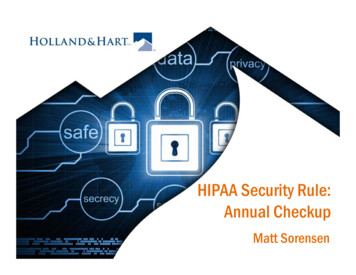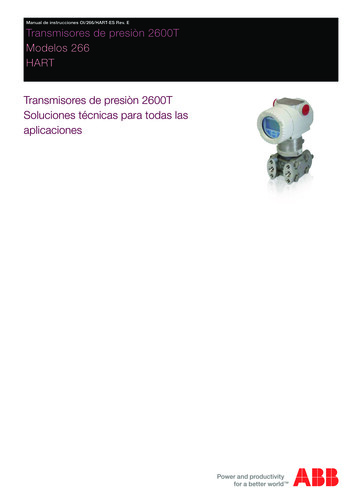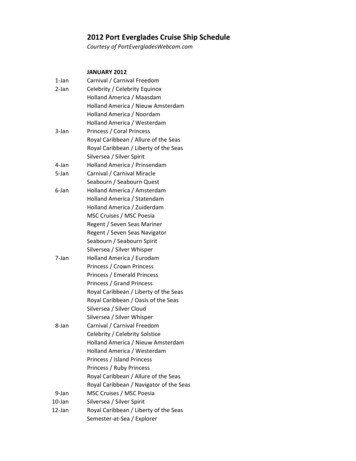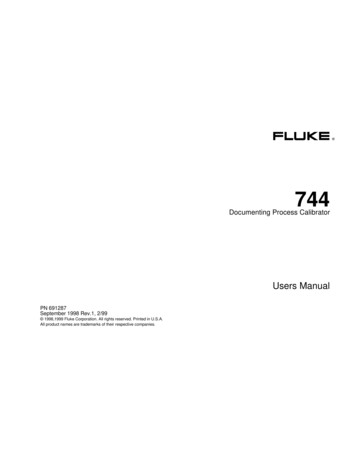
Transcription
HIPAA Security Rule:Annual CheckupMatt Sorensen
DisclaimerThis presentation is similar to any other legal educationmaterials designed to provide general information onpertinent legal topics. The statements made as part of thepresentation are provided for educational purposes only.They do not constitute legal advice nor do they necessarilyreflect the views of Holland & Hart LLP or any of its attorneysother than the speaker. This presentation is not intended tocreate an attorney‐client relationship between you andHolland & Hart LLP. If you have specific questions as to theapplication of law to your activities, you should seek theadvice of your legal counsel.
Agenda Security traps demonstrated by recent OCRsettlements Performing and documenting a risk assessment Required safeguards: what you really need toaddress To encrypt or not to encrypt: mobile devices, e‐mails, texts and other communications OCR guidance concerning cloud computing,ransomware, and other items
Recent OCR Actions
Children’s Medical Center of Dallas February 2, 2017: 3.2 Million FineLost Blackberry in 2010 (3,800 ePHI records)Lost laptop in 2013 (2,462 ePHI records)“impermissible disclosure of unsecured (ePHI)and non‐compliance over many years withmultiple standards of the HIPAA Security Rule.”– Lack of risk management plans– No encryption on mobile devices– Ineffective physical access �notice‐of‐proposed‐determination.pdf
Children’s Medical Center of Dallas Notice of Proposed Determination– No Request for Hearing “opportunity to provide written evidence of mitigatingfactors or affirmative defenses and/or written evidencein support of a waiver of a [civil monetary penalty]” Aggravating Factors– continued use of unencrypted devices from 2008 to2013– prior history of non‐compliance losses of laptop, blackberry put them on notice of activerisk of compromise of ePHI and non‐compliance Reportable incidents in 2008, 2009, 2010, 2013
MAPFRE Life Insurance of Puerto Rico January 18, 2017: 2.2 Million Fine “With this resolution amount, OCRbalanced potential violations of the HIPAARules with evidence provided by MAPFREwith regard to its present financialstanding.” Stolen USB memory stick, 2011 (2,209 portance‐implementing‐safeguards‐ephi.html
MAPFRE Life Insurance of Puerto Rico “Failure to conduct its risk analysis andimplement risk management plans, contrary toits prior representations, and a failure todeploy encryption or an equivalent alternativemeasure on its laptops and removable storagemedia until September 1, 2014. “MAPFRE also failed to implement or delayedimplementing other corrective measures itinformed OCR it would undertake.”
Other OCR Actions 475,000 for lack of timely breach notification(Presence Health) 400,000 for failure to update BAA for over ten years(CARE New England Health System)– “WIH failed to renew or modify its existing written businessassociate agreement with Care New England Health System, itsbusiness associate, to include the applicable implementationspecifications required by the Privacy and Security Rules.” 2.75 Million (University of Mississippi Med Center)– breach of ePHI of “10,000 individuals. During the investigation,OCR determined that UMMC was aware of risks and vulnerabilitiesto its systems as far back as April 2005, yet no significant riskmanagement activity occurred until after the breach, due largelyto organizational deficiencies and insufficient /files/9‐14‐16‐wih‐racap‐1.pdf
Other OCR Actions 2.7 Million– lost laptop (4,022 ePHI records)– lack of BAA with third‐party cloud storage provider whosuffered a breach (3,044 ePHI records) How many improvement could you make with 2.7million?– “We made significant data security enhancements at thetime of the incidents and now are investing at anunprecedented level in proactive measures to furthersafeguard patient information,” Barnes continued. “In theface of these challenges, OHSU is proactively working toensure the creation of a sustainable gold standard forprotected health information security and vil‐rights‐two‐hipaa‐breaches
Summary of Recent Issues Missing or outdated BAAs Missing or inadequate risk assessment Failure to act in the face of known risks– failure to encrypt– failure to restrict access (physical & logical) Failure to perform timely breachnotification Failure to respond to OCR Notice ofDetermination
Performing & Documentingthe Risk Assessment
HIPAA Security Rule 45 CFR 164.302-318 164.306 (General Requirements)– (a)(1) Ensure the confidentiality, integrity,and availability of all electronic protected healthinformation the covered entity or business associatecreates, receives, maintains, or transmits.– (a)(2) Protect against any reasonably anticipated threatsor hazards to the security or integrity of suchinformation.– (a)(3) Protect against any reasonablyanticipated uses or disclosures of such information
HIPAA Security Rule 164.308 (Administrative Safeguards)– (a)(1)(i) Standard: Security Management Process Implement policies and procedures to prevent, detect, contain,and correct security violations.– (a)(1)(ii) Implementation Specifications: (ii)(A) Risk Analysis: Conduct an accurate and thoroughassessment of the potential risks and vulnerabilities tothe confidentiality, integrity and availability of electronicprotected health information. (ii)(B) Risk Management: Implement security measuressufficient to reduce risks and vulnerabilities to a reasonableand appropriate level to comply with § 164.306(a).
HIPAA Security Rule - Documentation 164.316(B)(1)(ii): Ifan action, activityor assessment isrequired by thissubpart to bedocumented,maintain a written(which may beelectronic) recordof the action,activity, orassessment.
Risk Management & AnalysisSecurity Activities:Safeguards & ControlsRiskManagementRisk AnalysisFeedback& Results
NIST Standards“Covered entities may use any of the NISTdocuments to the extent that they providerelevant guidance to that organization’simplementation activities. While NISTdocuments were referenced in the preambleto the Security Rule, this does not make themrequired. In fact, some of the documents maynot be relevant to small organizations, as theywere intended more for large, governmentalorganizations.” – Source: CMS FAQ on Security Rule.
NIST Standards 800-39: Managing Information Security Risk 800-37: Risk Management Framework 800-30: Risk Assessment
Risk Management & AnalysisSecurity Activities:Safeguards & ControlsNIST SP 800‐37NIST SP 800‐39RiskManagementFeedback& Results1. Develop and implementa risk management plan.2. Implement securitymeasures.3. Evaluate and maintainsecurity measures.Risk Analysis1. Administrative2. Physical3. TechnicalNIST SP 800‐301. Identify the scope of the analysis.2. Gather data.3. Identify and document potential threatsand vulnerabilities.4. Assess current security measures.5. Determine the likelihood of threatoccurrence.6. Determine the potential impact of threatoccurrence.7. Determine the level of risk.8. Identify security measures and finalizedocumentation
Risk Analysis StepsRisk Analysis1. Identify the scope of the analysis2. Gather data3. Identify and document potential threats and vulnerabilities4. Assess current security measures5. Determine the likelihood of threat occurrence6. Determine the potential impact of threat occurrence7. Determine the level of risk8. Identify security measures and finalize documentation
Risk LevelSource: http://the‐outsourcing.com/subpage.php?pn region®id 1&aid 274
Risk Assessment What is not considered a risk assessment:– Gap Assessment against the implementationspecifications– A list of threats and corresponding safeguards– follow all the steps– show deliberation in: identifying all ePHI completing inventories threat identification, likelihood and impact analysis
Risk Assessment Common Mistakes:– Failure to account for Third-Party Risk SAAS, Cloud, Business Associates Right to audit, over-reliance in absence of SOC 2 Misunderstanding of SOC 1 vs. SOC 2 reports– Failure to complete and inventory of ePHI and systems– Not conducting a risk assessment as defined, opting forgap analysis– No risk assessment at all!– No minutes of board deliberations, management action
Risk Assessment Guidance Risk Assessment Guidance Security Risk Assessment Tool– HealthIT.gov– Windows and iPad version– Paper versions– User guide– No guarantee of compliant ty‐risk‐assessment‐tool
Required & AddressableSafeguards
Required vs. Addressable Required– the implementation specification must beimplemented Addressable– The concept of "addressable implementationspecifications" was developed to providecovered entities additional flexibility withrespect to compliance with the securitystandards.
Addressable A covered entity will do one of the followingfor each addressable specification:– (a) implement the addressable implementationspecifications; (if it is reasonable and appropriateto do so)– (b) implement one or more alternative securitymeasures to accomplish the same purpose; (if theaddressable implementation specification isunreasonable and inappropriate, and there is areasonable and appropriate alternative.)– (c) not implement either an addressableimplementation specification or an alternative.
Documentation of Decisions This decision will depend on a variety of factors suchas:––––the entity's risk analysis,risk mitigation strategy,what security measures are already in place,the cost of implementation. The decisions that a covered entity makes regardingaddressable specifications must be documented inwriting. The written documentation should include thefactors considered as well as the results of the riskassessment on which the decision was based.
Administrative Safeguards
Physical Safeguards
Technical Safeguards
HIPAA Security Rule 164.306 (General Requirements)– (b) Flexibility of Approach Choose Security Measures That Are Reasonable & Appropriate– How do we know what is Reasonable & Appropriate? size and complexitytechnical infrastructure, hardware, and security capabilitiescost of security measuresprobability and criticality of potential risks to ePHI– (c) Standards– (d) Implementation Specifications
Encryption
What to Encrypt? Whether you encrypt depends on your risk assessmentHowever:– Failure to encrypt PHI on mobile devices is asking for big trouble– Why is PHI on mobile devices in the first place? Document the business reasons, then the risks (threats and vulnerabilities) includingimpact and likelihood Then document the chosen safeguard: encryption PHI at Rest– in database– in flat files PHI in Transit––––Email (Why is PHI in email? See above)EMRThird Party Service ProviderText Messages (Why is PHI in text messages? See above)
Mobile Device Guidance Five Steps1. Decide whether mobile devices will access, transmitor store PHI or function as part of EMR system2. Assess the risks (threats and vulnerabilities)3. Identify mobile device risk management strategy,including safeguards4. Develop, Document, Implement5. Train: Security obile‐devices‐used‐health‐care‐pro
Hot Topics
Ransomware “Ransomware infections are security incident under theSecurity Rule” “Once detected the covered entity must initiate itssecurity incident and response and reportingprocedures.” “Part of a deeper analysis should involve assessingwhether or not there was a breach of PHI as a result ofthe security incident.” “The presence of ransomware (or any malware) is asecurity incident under HIPAA that may also result in animpermissible disclosure of PHI in violation of thePrivacy Rule and a breach, depending on the facts andcircumstances of the /files/RansomwareFactSheet.pdf
Cloud Computing Business Associate Agreements– Right to audit– Attestation Requirements– Incident Procedures; Notification Requirements Third‐Party Risk Management– Risk Assessment– SOC 2– Regular Vulnerability Assessments
NIST Cybersecurity Framework Barack Obama, Exec Order 13636 (Feb. 2013)– Improving Critical Infrastructure Cybersecurity– Partnership between government and owners andoperators of critical infrastructure– Improve cybersecurity information sharing ISAOs & ISACs (See EO 13691)– Collaboratively develop and implement risk‐basedstandards– NIST had one year to: work with private sector identify existing voluntary consensus standards and industrybest practices build them into a Cybersecurity Framework
PPD 21: Critical Infrastructure Security ChemicalCommercial FacilitiesCommunicationsCritical ManufacturingDamsDefense Industrial BaseEmergency ServicesEnergyFinancial ServicesFood and AgricultureGovt. FacilitiesHealthcare & PublicHealth Nuclear Reactors,Materials, Waste Transportation Water and Wastewater
NIST Cybersecurity Framework NIST CSF (Feb. 2014) Goal: Using the Framework’s structure willdrive companies to ask the right questionsand begin to implement the right solutionsfor their particular company and industry
NIST CSF Not one‐size‐fits‐all Complements, and does not replace, anorganization’s risk management process andcybersecurity program (assuming one exists) Three Parts:– Core– Profile– Implementation Tiers Contains a methodology to protect:– individual privacy– civil liberties
NIST CSF Building from those standards, guidelines, andpractices, the Framework provides a commontaxonomy and mechanism for organizations to:– Describe their current cybersecurity posture;– Describe their target state for cybersecurity;– Identify and prioritize opportunities forimprovement within the context of a continuousand repeatable process;– Assess progress toward the target state;– Communicate among internal and externalstakeholders about cybersecurity risk.
NIST CSF: CORE
dex.html?language es
Implementation Tiers Factors– Risk Management Process ad hoc, reactive, formal?– Integrated Risk Management Program information sharing internally, executive support, funding,measurement– External Participation ability to interact and share information externally Tiers––––PartialRisk InformedRepeatableAdaptive
How To Use NIST CSF Basic review of cybersecurity practices– Functions, categories, subcategories Communicate cybersecurity requirementswith stakeholders Identify opportunities for new or revisedinformative references
How To Use NIST CSF (cont.) Establish or Improve A Cybersecurity Program– Step 1: Prioritize and Scope– Step 2: Orient systems, information, assets, regulatory– Step 3: Create a Current Profile which categories/subcategories are working– Step 4: Conduct a Risk Assessment discern likelihood and impact (more next time) incorporate threat and vulnerability information– Step 5: Create a Target Profile which categories/subcategories are needed– Step 6: Determine, Analyze, Prioritize Gaps Compare current to target profile– Step 7: Implement Action Plan
Thanks forParticipatingKim Stangerkcstanger@hollandhart.comMatt Sorensencmsorensen@hollandhart.com
HIPAA Security Rule. Encryption. What to Encrypt? Whether you encrypt depends on your risk assessment However: - Failure to encrypt PHI on mobile devices is asking for big trouble - Why is PHI on mobile devices in the first place? Document the business reasons, then the risks (threats and vulnerabilities) including .










